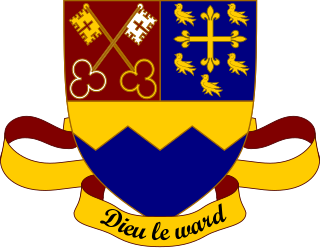Related Research Articles

St Benet's Hall is a Permanent Private Hall (PPH) of the University of Oxford. Its principal building is located at the northern end of St Giles' on its western side, close to the junction with Woodstock Road, Oxford. Established in 1897 by Ampleforth Abbey, St Benet's Hall original historic function was to allow its monks to be able to study for secular degrees at the university. The hall historically has a Benedictine and Roman Catholic ethos. Today, St Benet's Hall hosts an international community consisting of 84 undergraduate students and 48 graduate students of all faiths and none. Unlike other Colleges, St Benet's Hall does not have a High Table, but one Common Table which is shared by all members of the Hall.

Peter Pilkington, Baron Pilkington of Oxenford was a British public school headmaster and a Conservative member of the House of Lords.

Ampleforth College is a co-educational independent day and boarding school in the village of Ampleforth, North Yorkshire, England. It opened in 1802 as a boys' school, and is run by the Benedictine monks at Ampleforth Abbey. The school is in a valley with sports pitches, wooded areas and lakes. Its affiliated preparatory school, St Martin's Ampleforth, which lay across the valley at Gilling Castle, closed in 2020.

Bradfield College, formally St Andrew's College, Bradfield, is a public school for pupils aged 11–18, located in the small village of Bradfield in the English county of Berkshire. It is noted for producing plays in Ancient Greek and its open-air amphitheatre.
The Saint Louis Priory School, a Catholic secondary day school for boys, is located on a 150-acre campus in Creve Coeur, suburban St. Louis, Missouri, within the Archdiocese of Saint Louis. The school is run by the Benedictine monks of Saint Louis Abbey as part of their religious ministry.

George Basil Hume was an English Catholic bishop. He was a monk and priest of the English Benedictine monastery of Ampleforth Abbey and its abbot for 13 years until his appointment as Archbishop of Westminster in 1976. His elevation to cardinal of the Roman Catholic Church followed during the same year. From 1979, Hume served also as president of the Catholic Bishops' Conference of England and Wales. He held these appointments until his death from cancer in 1999. His final resting place is at Westminster Cathedral in the Chapel of St Gregory and St Augustine.
Charles Evelyn George Cary-Elwes, professed a monk as Dom Columba Cary-Elwes, OSB, of Ampleforth Abbey in York, England. As a missionary he travelled to Uganda, Tanzania and Kenya and has written books on Christianity. He was the founding prior of the Priory of Saints Louis and Mary in Saint Louis, Missouri.

Henry Wansbrough is an English biblical scholar, Roman Catholic priest, and monk of Ampleforth Abbey. From 1990 to 2004, he served as Master of St Benet's Hall, Oxford.

Anthony Chenevix-Trench was a British schoolteacher and classics scholar. He was born in British India, educated at Shrewsbury School and Christ Church, Oxford, and served in the Second World War as an artillery officer with British Indian units in Malaya. Captured by the Japanese in Singapore, he was forced to work on the Burma Railway.
The Revd Dom Felix Stephens, OSB was Master of St Benet's Hall, Oxford from 2007 to 2012.

Herbert Armitage James, CH was a Welsh cleric and headmaster of three leading public schools, who ended his "remarkable scholastic career", as it was later described by Austen Chamberlain, by becoming President of St John's College, Oxford. After an Oxford education and early teaching career at Marlborough College, he was headmaster of Rossall School from 1875 to 1886. It was said that he raised the school "to a pitch of all-round excellence which it had not known before". After suffering from health problems at Rossall, he served as Dean of St Asaph from 1886 to 1889. He returned to teaching in 1889, becoming headmaster of Cheltenham College and remaining in this post until 1895, despite being offered the position of headmaster of Clifton College. He then became headmaster of Rugby School and served there to great acclaim. His Rugby School nickname of "The Bodger" is still in use at the school. He left Rugby School in 1909 to become President of St John's College, Oxford, a position he held until his death 22 years later.

Ampleforth Abbey is a monastery of Benedictine Monks a mile to the east of Ampleforth, North Yorkshire, England, part of the English Benedictine Congregation. It claims descent from the pre-Reformation community at Westminster Abbey through the last surviving monk from Westminster Sigebert Buckley. As of 2020, the monastery has 53 monks.
Herbert Leo Price was a sportsman and schoolmaster. He achieved the unusual feat of playing rugby and hockey for England on consecutive Saturdays. He also played first-class cricket with Oxford University and club rugby for Leicester Tigers and Harlequins.
Dom Benet Perceval, OSB was the oldest member of the monastic community at Ampleforth Abbey, England, when he died at age 92 on 30 January 2009.
John Comyn Vaughan Wilkes was an English educationalist, who was Warden of Radley College and an Anglican priest.
Dom Fabian Cowper, OSB, a monk of Ampleforth Abbey, was an English Roman Catholic monk, who served as Master of St Benet's Hall, Oxford from 1989 until his death in 1990.
The sexual abuse scandal in the English Benedictine Congregation was a significant episode in the series of Catholic sex abuse cases in the United Kingdom. The dates of the events covered here range from the 1960s to the 2010s.
Edward Bernard Green OSB was an English Catholic priest, Benedictine monk of Ampleforth Abbey, and historian.
Robin Dyer is a former English cricketer and is the Headmaster of Ampleforth College, a co-educational Catholic boarding school in North Yorkshire.
References
- ↑ "Fr Leo Chamberlain OSB (1940 – 2019). | Ampleforth Abbey".
- ↑ "News". 19 September 2019.